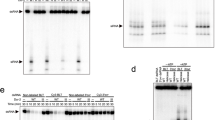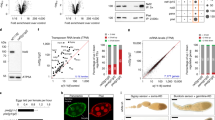Abstract
In Drosophila melanogaster, the small interfering RNA (siRNA) pathway is triggered by exogenous double-stranded RNA (dsRNA) or upon viral infection. This pathway requires Dicer-2 (Dcr-2) in association with a dsRNA-binding protein (dsRBP) called R2D2. A potentially distinct siRNA pathway, which requires Dcr-2 in association with a different dsRBP, called Loquacious (Loqs), is activated by endogenous dsRNA derived from transposons, structured loci and overlapping transcripts. Here we show that different sources of dsRNA enter a common siRNA pathway that requires R2D2 and Loqs. R2D2 and loqs mutants show impaired silencing triggered by injection of exogenous dsRNA or by artificial and natural expression of endogenous dsRNA. In addition, we show that these dsRBPs function sequentially and nonredundantly in collaboration with Dcr-2. Loqs is primarily required for dsRNA processing, whereas R2D2 is essential for the subsequent loading of siRNAs into effector Ago–RISC complexes.
This is a preview of subscription content, access via your institution
Access options
Subscribe to this journal
Receive 12 print issues and online access
$189.00 per year
only $15.75 per issue
Buy this article
- Purchase on Springer Link
- Instant access to full article PDF
Prices may be subject to local taxes which are calculated during checkout






Similar content being viewed by others
Accession codes
References
Carthew, R.W. & Sontheimer, E.J. Origins and mechanisms of miRNAs and siRNAs. Cell 136, 642–655 (2009).
Liu, X. et al. Dicer-1, but not Loquacious, is critical for assembly of miRNA-induced silencing complexes. RNA 13, 2324–2329 (2007).
Liu, Q. et al. R2D2, a bridge between the initiation and effector steps of the Drosophila RNAi pathway. Science 301, 1921–1925 (2003).
Pham, J.W., Pellino, J.L., Lee, Y.S., Carthew, R.W. & Sontheimer, E.J. A Dicer-2-dependent 80S complex cleaves targeted mRNAs during RNAi in Drosophila. Cell 117, 83–94 (2004).
Chung, W.J., Okamura, K., Martin, R. & Lai, E.C. Endogenous RNA interference provides a somatic defense against Drosophila transposons. Curr. Biol. 18, 795–802 (2008).
Czech, B. et al. An endogenous small interfering RNA pathway in Drosophila. Nature 453, 798–802 (2008).
Ghildiyal, M. et al. Endogenous siRNAs derived from transposons and mRNAs in Drosophila somatic cells. Science 320, 1077–1081 (2008).
Kawamura, Y. et al. Drosophila endogenous small RNAs bind to Argonaute 2 in somatic cells. Nature 453, 793–797 (2008).
Okamura, K., Balla, S., Martin, R., Liu, N. & Lai, E.C. Two distinct mechanisms generate endogenous siRNAs from bidirectional transcription in Drosophila melanogaster. Nat. Struct. Mol. Biol. 15, 581–590 (2008).
Okamura, K. et al. The Drosophila hairpin RNA pathway generates endogenous short interfering RNAs. Nature 453, 803–806 (2008).
Tam, O.H. et al. Pseudogene-derived small interfering RNAs regulate gene expression in mouse oocytes. Nature 453, 534–538 (2008).
Watanabe, T. et al. Endogenous siRNAs from naturally formed dsRNAs regulate transcripts in mouse oocytes. Nature 453, 539–543 (2008).
Ambros, V., Lee, R.C., Lavanway, A., Williams, P.T. & Jewell, D. MicroRNAs and other tiny endogenous RNAs in C. elegans. Curr. Biol. 13, 807–818 (2003).
Pak, J. & Fire, A. Distinct populations of primary and secondary effectors during RNAi in C. elegans. Science 315, 241–244 (2007).
Ghildiyal, M. & Zamore, P.D. Small silencing RNAs: an expanding universe. Nat. Rev. Genet. 10, 94–108 (2009).
Okamura, K. & Lai, E.C. Endogenous small interfering RNAs in animals. Nat. Rev. Mol. Cell Biol. 9, 673–678 (2008).
Zhou, R. et al. Processing of Drosophila endo-siRNAs depends on a specific Loquacious isoform. RNA 15, 1886–1895 (2009).
Liu, X., Jiang, F., Kalidas, S., Smith, D. & Liu, Q. Dicer-2 and R2D2 coordinately bind siRNA to promote assembly of the siRISC complexes. RNA 12, 1514–1520 (2006).
Tomari, Y., Matranga, C., Haley, B., Martinez, N. & Zamore, P.D. A protein sensor for siRNA asymmetry. Science 306, 1377–1380 (2004).
Wang, X.H. et al. RNA interference directs innate immunity against viruses in adult Drosophila. Science 312, 452–454 (2006).
Saleh, M.C. et al. The endocytic pathway mediates cell entry of dsRNA to induce RNAi silencing. Nat. Cell Biol. 8, 793–802 (2006).
Ulvila, J. et al. Double-stranded RNA is internalized by scavenger receptor-mediated endocytosis in Drosophila S2 cells. J. Biol. Chem. 281, 14370–14375 (2006).
Zhou, R. et al. Comparative analysis of Argonaute-dependent small RNA pathways in Drosophila. Mol. Cell 32, 592–599 (2008).
Dorner, S. et al. A genomewide screen for components of the RNAi pathway in Drosophila cultured cells. Proc. Natl. Acad. Sci. USA 103, 11880–11885 (2006).
Okamura, K., Ishizuka, A., Siomi, H. & Siomi, M.C. Distinct roles for Argonaute proteins in small RNA-directed RNA cleavage pathways. Genes Dev. 18, 1655–1666 (2004).
Lee, Y.S. et al. Distinct roles for Drosophila Dicer-1 and Dicer-2 in the siRNA/miRNA silencing pathways. Cell 117, 69–81 (2004).
Park, J.K., Liu, X., Strauss, T.J., McKearin, D.M. & Liu, Q. The miRNA pathway intrinsically controls self-renewal of Drosophila germline stem cells. Curr. Biol. 17, 533–538 (2007).
Förstemann, K. et al. Normal microRNA maturation and germ-line stem cell maintenance requires Loquacious, a double-stranded RNA-binding domain protein. PLoS Biol. 3, e236 (2005).
Kennerdell, J.R., Yamaguchi, S. & Carthew, R.W. RNAi is activated during Drosophila oocyte maturation in a manner dependent on Aubergine and spindle-E. Genes Dev. 16, 1884–1889 (2002).
Pham, J.W. & Sontheimer, E.J. Molecular requirements for RNA-induced silencing complex assembly in the Drosophila RNA interference pathway. J. Biol. Chem. 280, 39278–39283 (2005).
Jiang, F. et al. Dicer-1 and R3D1-L catalyze microRNA maturation in Drosophila. Genes Dev. 19, 1674–1679 (2005).
Horwich, M.D. et al. The Drosophila RNA methyltransferase, DmHen1, modifies germline piRNAs and single-stranded siRNAs in RISC. Curr. Biol. 17, 1265–1272 (2007).
Li, J., Yang, Z., Yu, B., Liu, J. & Chen, X. Methylation protects miRNAs and siRNAs from a 3′-end uridylation activity in Arabidopsis. Curr. Biol. 15, 1501–1507 (2005).
Stapleton, M. et al. The Drosophila gene collection: identification of putative full-length cDNAs for 70% of D. melanogaster genes. Genome Res. 12, 1294–1300 (2002).
Malone, C.D. & Hannon, G.J. Small RNAs as guardians of the genome. Cell 136, 656–668 (2009).
Provost, P. et al. Ribonuclease activity and RNA binding of recombinant human Dicer. EMBO J. 21, 5864–5874 (2002).
Tomari, Y., Du, T. & Zamore, P.D. Sorting of Drosophila small silencing RNAs. Cell 130, 299–308 (2007).
Kok, K.H., Ng, M.H., Ching, Y.P. & Jin, D.Y. Human TRBP and PACT directly interact with each other and associate with dicer to facilitate the production of small interfering RNA. J. Biol. Chem. 282, 17649–17657 (2007).
Lu, C., Meyers, B.C. & Green, P.J. Construction of small RNA cDNA libraries for deep sequencing. Methods 43, 110–117 (2007).
Pall, G.S., Codony-Servat, C., Byrne, J., Ritchie, L. & Hamilton, A. Carbodiimide-mediated cross-linking of RNA to nylon membranes improves the detection of siRNA, miRNA and piRNA by northern blot. Nucleic Acids Res. 35, e60 (2007).
Tuschl, T., Zamore, P.D., Lehmann, R., Bartel, D.P. & Sharp, P.A. Targeted mRNA degradation by double-stranded RNA in vitro. Genes Dev. 13, 3191–3197 (1999).
Fahlgren, N. et al. Computational and analytical framework for small RNA profiling by high-throughput sequencing. RNA 15, 992–1002 (2009).
Acknowledgements
We thank C. Reinke, Y. Bei and Carthew laboratory members for valuable discussion; F. Valsecchi for help with bioinformatics; C. Horvath, E. Sontheimer and J. Brickner (Northwestern University) for sharing equipment and reagents; P. Zamore (University of Massachusetts Medical School) for loqsf00791; M. Siomi (Keio University School of Medicine) for ago2414 stocks; Q. Liu (University of Texas Southwestern Medical Center) for R2D21 and loqsKO stocks and G. Hannon (Cold Spring Harbor Laboratory) for anti-Loqs antibody. This work was supported by a grant from the US National Institutes of Health (GM68743) to R.W.C.
Author information
Authors and Affiliations
Contributions
J.T.M. and K.K. conceived and designed the experiments; J.T.M., K.K., P.-H.W., T.M.A. and N.J. performed the experiments; J.T.M., K.K. and R.W.C. analyzed the data; J.T.M. and R.W.C. wrote the paper.
Corresponding author
Supplementary information
Supplementary Text and Figures
Supplementary Figures 1–7, Supplementary Tables 1 and 2 and Supplementary Methods (PDF 2354 kb)
Rights and permissions
About this article
Cite this article
Marques, J., Kim, K., Wu, PH. et al. Loqs and R2D2 act sequentially in the siRNA pathway in Drosophila. Nat Struct Mol Biol 17, 24–30 (2010). https://doi.org/10.1038/nsmb.1735
Received:
Accepted:
Published:
Issue Date:
DOI: https://doi.org/10.1038/nsmb.1735
This article is cited by
-
Neofunctionalization driven by positive selection led to the retention of the loqs2 gene encoding an Aedes specific dsRNA binding protein
BMC Biology (2024)
-
Blood-feeding adaptations and virome assessment of the poultry red mite Dermanyssus gallinae guided by RNA-seq
Communications Biology (2023)
-
Mosquito vector competence for dengue is modulated by insect-specific viruses
Nature Microbiology (2023)
-
Low dose rate γ-irradiation protects fruit fly chromosomes from double strand breaks and telomere fusions by reducing the esi-RNA biogenesis factor Loquacious
Communications Biology (2022)
-
Does the Global Outbreak of COVID-19 or Other Viral Diseases Threaten the Stem Cell Reservoir Inside the Body?
Stem Cell Reviews and Reports (2021)



